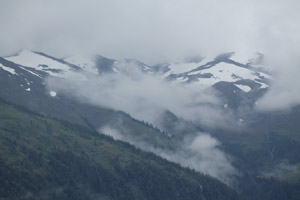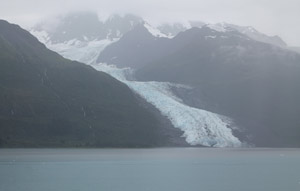College Fjord opens off Prince William Sound, which in turn opens off the Gulf of Alaska.
 Prince William Sound was named by British explorer Captain James Cook, in honour of Prince William Henry, one of George III’s sons. The largest town is Valdez, the southern terminus of the Alaska Pipeline and oil tankers sail through the Sound on a regular basis. The area is known for two famous natural disasters.
Prince William Sound was named by British explorer Captain James Cook, in honour of Prince William Henry, one of George III’s sons. The largest town is Valdez, the southern terminus of the Alaska Pipeline and oil tankers sail through the Sound on a regular basis. The area is known for two famous natural disasters.
In 1964 one of the most powerful earthquakes in North America hit Alaska. The earthquake was rated a 9.2. Valdez was devastated and a tsunami destroyed nearby native communities. It was particularly hard on Prince William Sound and the surrounding areas because epicenter was in College Fjord, which opens off the Sound.

The second disaster was actually man-made. In 1989 the Exxon Valdez, a fully loaded oil tanker out of Valdez ran aground and spilled its contents into Prince William Sound. The local wildlife was decimated and oil continues to float to the surface even now, almost forty years later.

 The glaciers that line College Fjord were named by members of the Harriman Expedition at the end of the nineteenth century. The extensive personnel included two professors from Ivy League universities who had the bright idea of naming the glaciers after prominent universities. The west side of the fjord is dedicated to famous women’s colleges like Bryn Mawr and Smith, while the east features men’s institutions including Harvard and Yale. Princeton, apparently deliberately, wasn’t included.
The glaciers that line College Fjord were named by members of the Harriman Expedition at the end of the nineteenth century. The extensive personnel included two professors from Ivy League universities who had the bright idea of naming the glaciers after prominent universities. The west side of the fjord is dedicated to famous women’s colleges like Bryn Mawr and Smith, while the east features men’s institutions including Harvard and Yale. Princeton, apparently deliberately, wasn’t included.
 As the previous day in Glacier Bay, we had a 360 degree view of the glaciers from our place in the Sanctuary. College Fjord is narrow, so you can see the glaciers on both sides at the same time. It was easy to slip from one side of the ship to the other to gawk and enjoy. We sailed slowly up, then back down the fjord for a few hours, then shortly before dinner, re-entered Prince William Sound and headed to Wittier, our final port of call.
As the previous day in Glacier Bay, we had a 360 degree view of the glaciers from our place in the Sanctuary. College Fjord is narrow, so you can see the glaciers on both sides at the same time. It was easy to slip from one side of the ship to the other to gawk and enjoy. We sailed slowly up, then back down the fjord for a few hours, then shortly before dinner, re-entered Prince William Sound and headed to Wittier, our final port of call.
